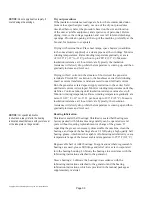
Page 28
Copyright © 2012 Kato Engineering, Inc. All rights reserved
Parallel operation
For the generator to operate in parallel with a system in operation, the
phase sequence of the generator must be the same as that of the system.
Use transformers to reduce the voltage to an acceptable level, and then
use a phase rotation meter or incandescent lamp method, described in
electrical machinery handbooks, for a phase sequence check.
The output voltage at the paralleling point must be the same as each
instant, which requires that the two voltages be of the same frequency,
same magnitude, same rotation, and in coincidence with each other.
Voltmeters indicate whether the voltage magnitude is the same, and
frequency meters indicate whether the frequencies are the same. Whether
the voltages are in phase and exactly at the same frequency is indicated
by a synchroscope or by synchronizing lamps.
A synchroscope can be used to indicate the difference in phase angle
between the incoming machine and the system. The generator can be
paralleled by using incandescent lamps connected as shown in Figure 21.
The voltage rating of the series lamps must equal the voltage rating of the
transformer-low voltage winding.
Each prime mover in the system must have the same speed regulating
characteristics, and the governors must be adjusted to give the same
speed regulation as determined by applying load that is proportional to
the full load rating of the generator.
The voltage regulator must include paralleling circuitry. In addition, the
voltage, droop settings and the V/Hz regulation characteristics must be
the same for all the voltage regulators. This will allow the generators to
properly share reactive loads.
If cross-current compensation is used, paralleling current transformers
must give the same secondary current.
Current transformer secondary windings provide reactive kVA droop
signal to the voltage regulator. Accidental reversal of this electrical
wiring will cause the voltage to attempt to rise with load rather than
droop. If this occurs during paralleling, stop the unit and reverse the
wires at the voltage regulator terminals.
If the set is provided with a unit/parallel switch, set the switch to the
parallel position on the unit being synchronized.
Synchronize the generator by adjusting the speed (frequency) slightly
higher than the system. Observe the synchroscope or the lamps. The
lamps should fl uctuate from bright to dark at the rate of one cycle every
2 to 3 seconds. When the generator is in phase (the lights will be dark),
close the circuit breaker. Immediately after closing the breaker, measure
NOTICE: Refer to the voltage regulator
manual for complete details and possible
additional instructions. Damage to the rotat-
ing diodes, generator, and voltage regulator
can be caused if the regulator is operated
improperly.
IMPORTANT: If the polarity of the exciter
is reversed by fl ashing the fi eld, it may be
corrected by interchanging the battery leads.
WARNING: Shock hazard - Do
not make connections or otherwise make
contact with the generator leads or other
devices connected to them unless the
genset is stopped and the phase leads are
grounded. A rotating generator is always
producing some voltage and contact with
the leads or other devices connected may
result in serious injury or death
















































